| Tamiya 1/48 Republic P-47D 'Razorback' Thunderbolt |  | Background The Thunderbolt traces its lineage back to the Seversky P-35, which featured less than half the horsepower within a much shorter fuselage. Armed with only a single 30 caliber and a single 50 caliber machine gun, the P-35 would serve on the front lines during the opening days of World War II, though it was no match for Japanese airpower of the day. As Seversky became Republic, it offered an improved version of the P-35 as the P-43 Lancer. It featured double the P-35's armament and two hundred additional horsepower. At best, the P-43 was a stop-gap airframe. The next version off of Republic's drawing boards was the P-47 Thunderbolt. Unlike its predecessors, the P-47 was huge, housing a 2,000 horsepower R-2800 Double Wasp with supercharger and eight 50 caliber machine guns in the wings. Combat units criticized the P-47 as it entered service, its immense size and weight earned it the nickname 'Juggernaut' (shortened to 'Jug'), but its range, stability, firepower, and its ability to absorb significant damage and still return led the P-47 to become a legend. Unlike any other fighter in the ETO, the Thunderbolt could escort bombers farther into Germany and double as effective ground attack platforms (until the P-51 Mustang entered the ETO). Nevertheless, the 56th Fighter Group earned its reputation operating the P-47 and was the only fighter group to refuse the Mustang, instead waiting for the P-47M. Over 12,600 P-47D's were produced, the initial versions retaining the Razorback profile of the P-35, P-43 and earlier P-47s. The Kit When Tamiya announced its P-47D Razorback kit earlier this year, the reaction was mixed. Hasegawa had already released a Razorback and Bubbletop P-47D a few years earlier (though both are frequently out of production now) and these were a significant improvement over the Monogram P-47s that had dominated the market previously. On the other hand, Tamiya tends to out-shine Hasegawa in many of its offerings so it we'd have to wait and see. Looking at the build-up examples at the 2002 RCHTA show didn't reveal anything to get excited about. When you get to look at the unassembled kit in person though, you'll be ready to eBay your Hasegawa Jugs. 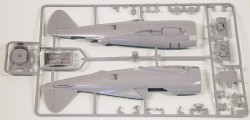 The kit is molded in light gray styrene with no ejector pin marks in areas that would be visible after assembly. Details are recessed/scribed and the level of detail throughout the kit is very striking. After a bit of fondling of the plastic, it appears that this kit will literally fall together with little or no work. Assembly is very straightforward and with no surprises. The kit is molded in light gray styrene with no ejector pin marks in areas that would be visible after assembly. Details are recessed/scribed and the level of detail throughout the kit is very striking. After a bit of fondling of the plastic, it appears that this kit will literally fall together with little or no work. Assembly is very straightforward and with no surprises.
In Step 1 alone, you'll see a cockpit so beautifully detailed that you'd swear that Black Box had designed the molds. While the pilot's seat does not have seatbelts/harnesses molded in place, Tamiya does provide the belts/harnesses as a decal. 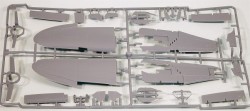 Step 2 carries forward the structural engineering that has been provided in many of the recent Tamiya releases. This is a dual spar wing box structure that mounts inside the fuselage and extends into the wings. This design ensures a strong wing/fuselage joint. Step 2 carries forward the structural engineering that has been provided in many of the recent Tamiya releases. This is a dual spar wing box structure that mounts inside the fuselage and extends into the wings. This design ensures a strong wing/fuselage joint.
Step 3 assembles the fuselage halves with the cockpit and wing box installed with the supercharger and engine firewall. Step 4 brings together a nice engine along with the complex ducting inside the cowling. Optional open or closed cowl flaps are provided. 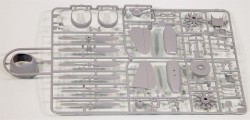 Step 5 installs the horizontal stabilizers and supercharger exhaust ducts. Optional open or closed supercharger fuselage doors are included. Step 5 installs the horizontal stabilizers and supercharger exhaust ducts. Optional open or closed supercharger fuselage doors are included.
Step 6 is the assembly of the wing halves. Step 7 is the installation of the wings onto the fuselage. The 50 caliber gun ports are also installed and they are accurately portrayed in the leading edge of the wing. Step 8 is the assembly of the landing gear and installation onto the wings/fuselage. You'll note the nicely detailed hydraulic actuators on the main wheel doors. 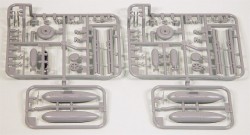 Step 9 is the assembly of the wing flaps. Hinges are provided to pose the flaps up or down. Step 9 is the assembly of the wing flaps. Hinges are provided to pose the flaps up or down.
Step 10 is the installation of the flaps onto the wings and the centerline pylon onto the fuselage. Step 11 is the assembly of one of the two types of propellers used in this kit (three types are provided). Step 12 focuses on the remaining aircraft details - gunsight, windscreen, canopy, gun barrels and antenna. 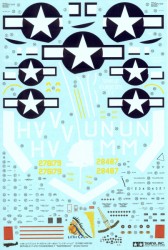 Step 13 - 15 deals with the external loadout options. This kit provides the standard 'flat' metal 150 gallon centerline fuel tank and two 108 gallon 'paper' fuel tanks. In addition, two sets of underwing bazooka rocket launches and two 500 lb bombs are provided along with two underwing pylons. Step 13 - 15 deals with the external loadout options. This kit provides the standard 'flat' metal 150 gallon centerline fuel tank and two 108 gallon 'paper' fuel tanks. In addition, two sets of underwing bazooka rocket launches and two 500 lb bombs are provided along with two underwing pylons.
Markings are provided for two aircraft: HV-V, 61 FS/56 FG, Halesworth UK, March 1944 as flown by Lt Frank Klibbe UN-M, 63 FS/56 FG, Halesworth UK, March 1944 as flown by Capt Walker Mahurin Conclusion The Monogram P-47s were outstanding kits in their day, featuring a great deal of detail. When the Hasegawa P-47s were released, the scribed details alone were a major improvement over the Monogram kits. The Tamiya P-47 is to the Hasegawa kit as the Hasegawa kit was to the Monogram P-47. The detailed cockpit, positionable wing flaps and cowl flaps, details inside the cowling, etc., make this kit a winner. | 







|

 The kit is molded in light gray styrene with no ejector pin marks in areas that would be visible after assembly. Details are recessed/scribed and the level of detail throughout the kit is very striking. After a bit of fondling of the plastic, it appears that this kit will literally fall together with little or no work. Assembly is very straightforward and with no surprises.
The kit is molded in light gray styrene with no ejector pin marks in areas that would be visible after assembly. Details are recessed/scribed and the level of detail throughout the kit is very striking. After a bit of fondling of the plastic, it appears that this kit will literally fall together with little or no work. Assembly is very straightforward and with no surprises. Step 2 carries forward the structural engineering that has been provided in many of the recent Tamiya releases. This is a dual spar wing box structure that mounts inside the fuselage and extends into the wings. This design ensures a strong wing/fuselage joint.
Step 2 carries forward the structural engineering that has been provided in many of the recent Tamiya releases. This is a dual spar wing box structure that mounts inside the fuselage and extends into the wings. This design ensures a strong wing/fuselage joint.  Step 5 installs the horizontal stabilizers and supercharger exhaust ducts. Optional open or closed supercharger fuselage doors are included.
Step 5 installs the horizontal stabilizers and supercharger exhaust ducts. Optional open or closed supercharger fuselage doors are included. Step 9 is the assembly of the wing flaps. Hinges are provided to pose the flaps up or down.
Step 9 is the assembly of the wing flaps. Hinges are provided to pose the flaps up or down. Step 13 - 15 deals with the external loadout options. This kit provides the standard 'flat' metal 150 gallon centerline fuel tank and two 108 gallon 'paper' fuel tanks. In addition, two sets of underwing bazooka rocket launches and two 500 lb bombs are provided along with two underwing pylons.
Step 13 - 15 deals with the external loadout options. This kit provides the standard 'flat' metal 150 gallon centerline fuel tank and two 108 gallon 'paper' fuel tanks. In addition, two sets of underwing bazooka rocket launches and two 500 lb bombs are provided along with two underwing pylons.






